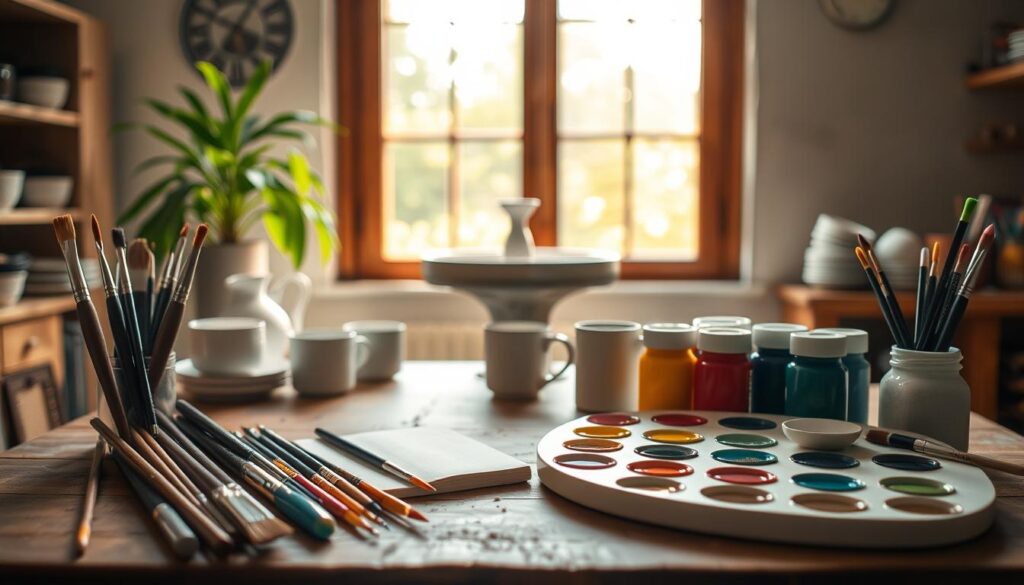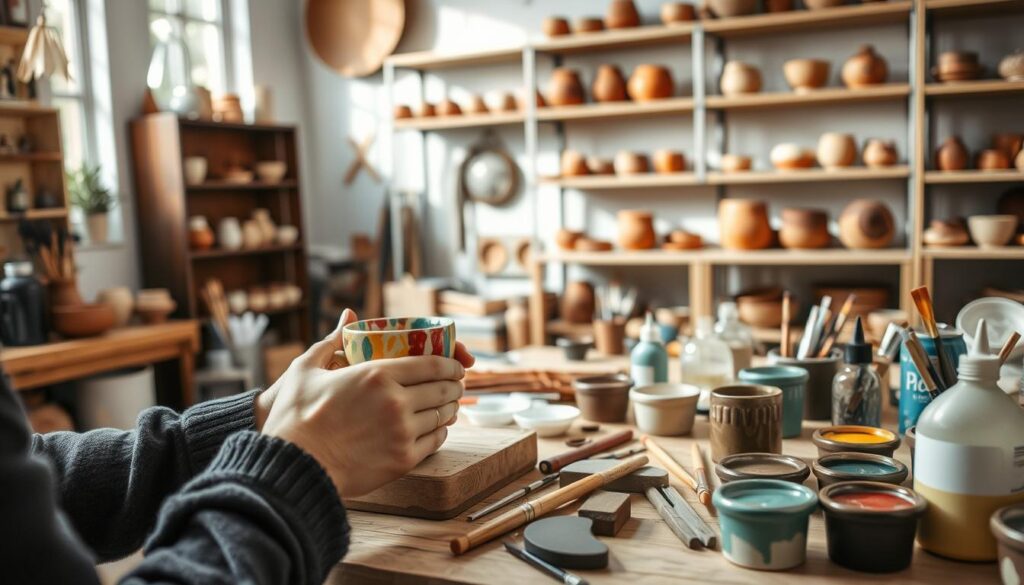Ever wanted to create personalized ceramics but felt intimidated by kilns or studio costs? You’re not alone. Modern DIY methods let anyone craft stunning pieces at home using simple tools and creative flair. This guide pulls inspiration from professional studios and artists to make the process accessible, affordable, and fun.
Whether you’re a first-timer or a seasoned crafter, you’ll learn how to select materials, apply designs, and finish projects without traditional firing. Forget complex equipment—we focus on air-dry clays, oven-safe paints, and sealants that deliver professional results. Plus, these techniques work for small decor items or functional pieces like mugs or bowls.
Looking for more hands-on home projects? Check out our guide to updating a fireplace with paint and for another weekend-friendly upgrade. Now, let’s dive into turning your ideas into tangible art!
Key Takeaways
- No kiln? No problem! Use air-dry clay or oven-baked paints for durable results.
- Beginners can start with pre-made bisque pieces to skip the shaping stage.
- Sealants like mod podge or resin protect finishes without high-heat methods.
- Mix stencils and freehand designs for professional-looking patterns.
- Experiment with textures using household items like sponges or lace.
Introduction to Kiln-Free Pottery Painting
What if you could create gallery-worthy ceramics without bulky equipment? Modern DIY methods have revolutionized home crafting, letting anyone design durable pieces using simple materials. This approach skips technical barriers, making it ideal for first-timers or casual creators.
Kiln-free techniques prioritize flexibility and affordability. You’ll work with air-dry clay or pre-made bisque items, eliminating the need for high-heat firing. Brands like Paint Your Own Pottery Studio show how these methods cut costs by 60% compared to traditional setups.
| Aspect | Traditional Methods | Kiln-Free Approach |
|---|---|---|
| Equipment | Kiln, glazes, studio space | Basic tools, oven-safe paints |
| Cost | $500+ startup | Under $50 |
| Time | Days (firing process) | Hours (air drying) |
The rise of kiln-free art traces back to 1970s craft movements, but recent innovations in sealants and clays have boosted its popularity. Today’s options let you experiment with textures and colors risk-free—no prior skills needed.
In this guide, we’ll walk through selecting materials, applying designs, and sealing finishes. You’ll learn how household items like sponges or lace can add professional flair. Ready to turn your kitchen table into a studio?
Essential Tools and Materials for DIY Pottery Painting
Transform your kitchen table into a creative hub with the right supplies. Quality tools and thoughtful workspace design turn ordinary projects into professional-grade art. Let’s explore what you’ll need to start crafting.

Curating Your Toolkit
Begin with these non-negotiable items:
- Detail brushes: Synthetic bristles (size 00-8) for precise lines
- Acrylic or ceramic paints labeled “oven-safe”
- Clear sealants like resin for lasting finishes
- Texturing tools: sponges, lace, or silicone stamps
Silver Sage Ceramics emphasizes bisqueware quality: “Thicker pieces withstand handling better during decoration.” Opt for pre-made items with smooth surfaces from trusted suppliers like Blick Art Materials.
Crafting Your Creative Space
Flydragon Studio’s layout principles show how environment fuels creativity. Aim for:
“Three zones: prep, painting, drying. Keep supplies within arm’s reach but organized.”
Prioritize natural light or daylight bulbs for color accuracy. Add a rotating display stand to view pieces from all angles. Local studios often offer inspiration boards—recreate this with Pinterest-worthy setups using mood lighting and ergonomic seating.
Step-by-Step DIY Pottery Painting Techniques
Crafting stunning ceramics at home starts with mastering a few fundamental steps. Whether you’re using a kitchen counter or a makeshift studio, these methods ensure crisp results without specialized equipment. Let’s break down the process into manageable stages.

Preparing Your Piece
Begin by wiping your bisqueware with a damp cloth to remove dust. PAINT YOUR OWN POTTERY STUDIO recommends using 220-grit sandpaper for rough spots: “A smooth surface helps colors adhere evenly.” Sketch designs lightly with a pencil—this blueprint prevents mistakes during the creative phase.
Wear cotton gloves to avoid transferring oils to the surface. For intricate projects, apply a thin layer of gesso primer. This creates a uniform base, especially helpful for light-colored paints.
Applying Color and Texture
Start with broad areas using flat brushes, then add details. Blend acrylics while wet for gradient effects. Pro tip: Dab a dry sponge over metallic paints to create stone-like finishes. Layering is key—allow each coat to dry completely before adding patterns.
Oven-safe glazes offer depth but require precise application. Test combinations on spare tiles first. For dimensional accents, press lace into wet paint or carve lines with toothpicks. Seal everything with water-based varnish to lock in vibrancy.
Pottery Painting Techniques for DIY Success
Transform hesitant first attempts into polished pieces using these beginner-friendly approaches. Drawing from Flydragon Studio’s workshops and Silver Sage Ceramics’ tutorials, we’ve distilled their best advice into actionable strategies for new creators.
Expert Tips for Beginners
Start with simple shapes like coasters or planters. These allow you to practice brush control without overwhelming details. Flydragon Studio suggests: “Limit your palette to 3 colors initially—master blending before expanding.”
Common challenges like uneven coats often stem from rushing. Apply thin layers, letting each dry fully. For crisp lines, use painter’s tape or stencils cut from vinyl sheets. Textured finishes? Press crumpled foil into wet paint for instant dimension.
- Rotate your piece every 5 minutes to spot missed areas
- Keep a “test tile” to experiment with color mixes
- Use toothpicks for dot patterns instead of expensive tools
Creative blocks? Silver Sage artists recommend themed challenges: “Try ‘monochrome madness’ or ‘texture Tuesday’ to spark ideas.” Local studios often host these events, creating a supportive space to share techniques.
Remember—your kitchen table is a studio. Organize supplies in labeled containers, and designate drying zones away from pets. With each project, you’ll develop instincts for color harmony and tool selection.
Enhancing Your Creative Experience in a Kiln-Free Studio
Crafting becomes richer when shared. Studios like Flydragon and Silver Sage Ceramics prove that collaboration fuels innovation, turning solo projects into collective masterpieces. Their community-driven events blend skill-building with social connection, making art accessible to all.
Spark Ideas Through Shared Creativity
Flydragon’s weekly open studio nights let creators swap techniques while working side-by-side. One participant noted: “Seeing others’ color combinations pushed me to try bolder palettes.” Silver Sage’s summer art camps pair beginners with mentors, accelerating skill development through guided challenges.
Local workshops often host themed events like “Texture Thursdays” or seasonal ornament-making classes. These structured sessions teach specific methods—think marbling with shaving cream or stamping with natural materials. Check studio websites for calendars, and sign up early—spots fill fast!
Beyond technical growth, these gatherings build lasting networks. Regulars at Silver Sage often trade materials, critique designs, and even collaborate on installations. As Flydragon’s director says: “Our space isn’t just about art—it’s where friendships and fresh ideas take shape.”
Ready to join? Many studios offer discounted multi-class packages or family-friendly hours. Bring a friend, embrace the energy of group creation, and watch your DIY projects reach new heights.
Conclusion
Unleash your inner artist with confidence—no fancy equipment required! Through simple materials like air-dry clay and oven-safe paints, you’ve seen how accessible ceramic creation can be. Just grab basic brushes, experiment with textures, and let sealants do the heavy lifting for lasting finishes.
Remember: success lies in smart prep work and playful experimentation. Sand surfaces smooth, layer colors strategically, and use stencils for crisp patterns. Local studios often host workshops that accelerate learning through shared tips—perfect for overcoming creative blocks.
What truly elevates this craft? Community. Whether swapping ideas at open studio nights or joining online challenges, collaboration fuels growth. As Flydragon Studio regulars prove, artistic breakthroughs often spark from group energy.
Ready to begin? Your kitchen table awaits. For more inspiration, explore our detailed pottery painting guide. Grab a bisque piece, mix your favorite hues, and let creativity flow—one brushstroke at a time.

